Most dangerous cities in Arkansas research summary. We analyzed the most recent FBI crime data using Saturday Night Science to determine the most dangerous cities in Arkansas.
We examined the violent and property crime per capita statistics for every place with over 5,000 residents. In total, we analyzed 67 Arkansas cities. Here are the results of our analysis:
-
The most dangerous city in Arkansas is Little Rock based on the most recent FBI crime data.
-
The violent crime rate in Arkansas is 1,833 per 100k people.
-
The property crime rate in Arkansas is 5,348 per 100k people.
-
The safest city in Arkansas is Greenbrier.
-
Arkansas is the 3rd most dangerous state in the United States.
Table Of Contents: Top Ten | Table | Methodology | FAQs | References
We used to think that the Walmart HQ in Bentonville going out of business would be one of the most dangerous things that could happen in Arkansas, but, sadly, that’s not the case.
There are dangerous places in The Natural State. And because not every place in Arkansas can be like the state’s safest place, Greenbrier, we set out to determine the most dangerous areas in Arkansas for 2024.
We consulted the FBI’s latest crime report for violent and property crime statistics per capita for every place with over 5,000 residents. In total, we analyzed 67 Arkansas cities. Cities like Pine Bluff and West Memphis just can’t catch a break.
The Most Dangerous Cities In Arkansas For 2024
What is the most dangerous place in Arkansas? The most dangerous place in Arkansas is Little Rock.
The top ten most dangerous places in Arkansas should come as no surprise to the good people of Arkansas. These cities helped solidify the state as the 3rd most dangerous state in the country.
For more Arkansas reading, check out:
- Most dangerous cities in the US
- Best Places To Live In Arkansas
- Cheapest Places To Live In Arkansas
- Best Places To Raise A Family In Arkansas
The 10 Most Dangerous Places To Live In Arkansas For 2024
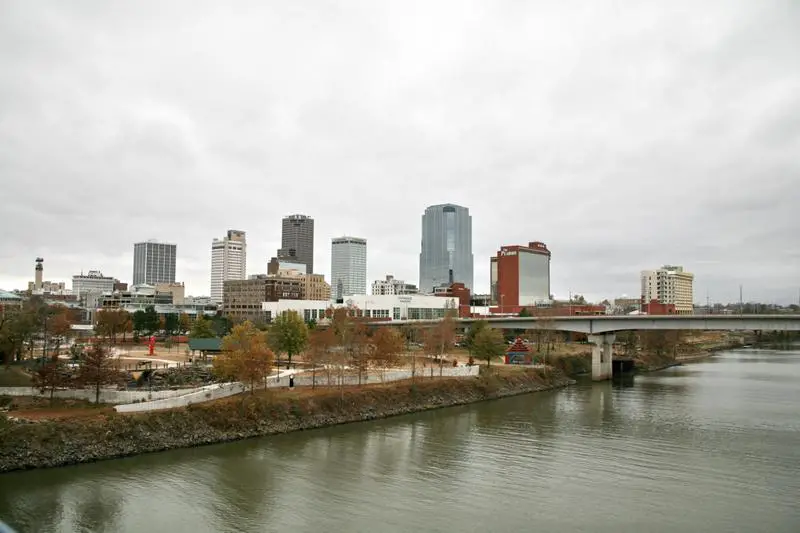
/10
Population: 201,513
Violent Crimes Per 100k: 1,833 (Fourth most dangerous)
Property Crimes Per 100k: 5,348 (Second most dangerous)
Murders: 79
More on Little Rock: Data | Crime | Cost Of Living
Unfortunately, Little Rock is again stuck at the top of the most dangerous places in Arkansas list. Little Rock residents have a 1 in 18 chance of being a victim of property crime, and they are particularly likely to be a victim of larceny, burglary, or car theft. Little Rock is not only the biggest city in Arkansas, but it is also one of the snobbiest places and one of the most expensive places to live in Arkansas.
Although the name may not be very exciting, Little Rock residents still think they have a lot to be snobby about.
Located smack-dab in the middle of Arkansas, Little Rock was named after a small rock formation on the Arkansas River’s south bank. Well, it probably sounded better when Jean-Baptiste Bernard de la Harpe said, “La Petite Roche”, but the name stuck.
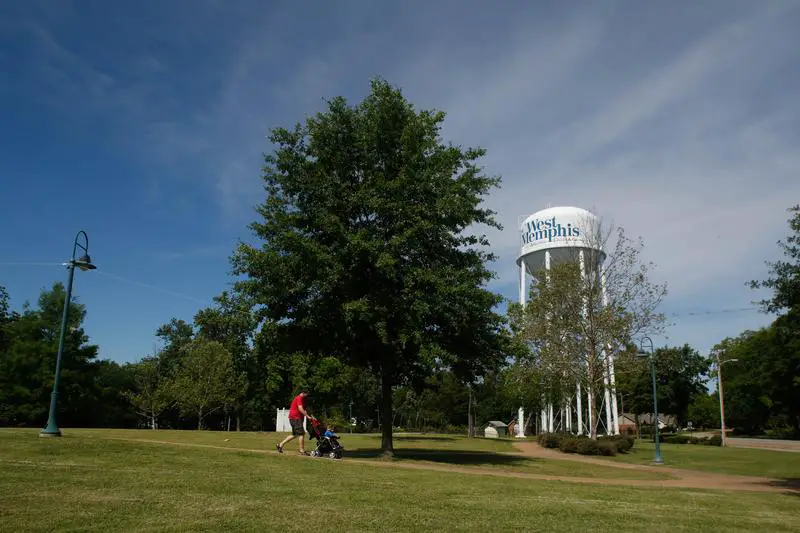
/10
Population: 23,809
Violent Crimes Per 100k: 2,637 (Most dangerous)
Property Crimes Per 100k: 4,750 (Sixth most dangerous)
Murders: 12
More on West Memphis: Data | Crime | Cost Of Living
Located across the Arkansas River from Memphis, Tennessee, West Memphis is not only known as one of the most dangerous cities in Arkansas but also one of the worst places to live in Arkansas as well.
West Memphis ranks highest in violent crime and sixth highest in property crime. Residents have a 1 in 37 chance of being a victim of murder, rape, or aggravated assault. Maybe “The Grind City” across the river is rubbing off on West Memphis.
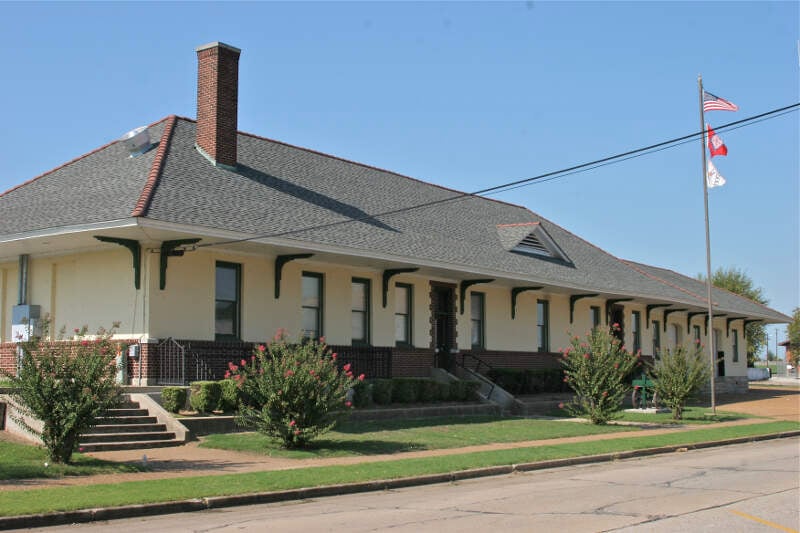
/10
Population: 7,335
Violent Crimes Per 100k: 1,622 (Eighth most dangerous)
Property Crimes Per 100k: 5,180 (Third most dangerous)
Murders: 0
More on Newport: Data | Crime | Cost Of Living
Not only is Newport one of the most dangerous places to live in Arkansas, but it’s also one of the worst places and thepoorest places to live in Arkansas as well. If you live in Newport you have a 1 in 19 chance of being a victim of property crime, that includes burglary, car theft and arson. Newport ranks eighth highest in violent crime and third highest in property crime.
Located on the White River 84 miles from Little Rock, Newport is the home to the Ben Franklin store where Sam Walton dreamed up his idea for Walmart. Be sure to keep your house and car doors locked in this small town.
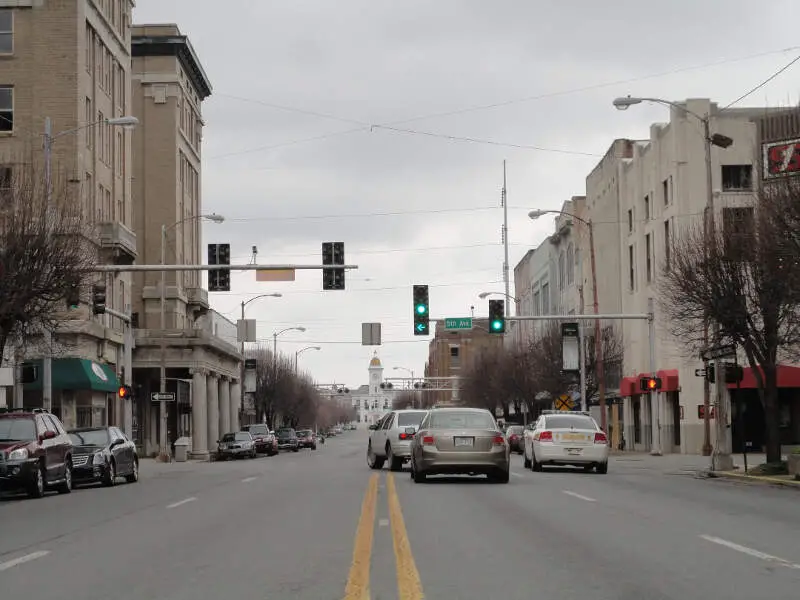
/10
Population: 39,549
Violent Crimes Per 100k: 1,628 (Seventh most dangerous)
Property Crimes Per 100k: 5,120 (Fourth most dangerous)
Murders: 17
More on Pine Bluff: Data | Crime | Cost Of Living
Pine Bluff has a history stretching back to at least 1839, when the community was first incorporated. Built along the Arkansas River, about 45 minutes southeast of Little Rock, the city keeps a sense of its history, providing a home to the Arkansas Railroad Museum.
So Pine Bluff has the history stuff covered. What about the present? Well, that’s when the trouble comes in. The town exists as the number 4 most dangerous spot in Arkansas.
Violence represents a major problem. In a community with a total population of 39,549, Pine Bluff suffered 17 murders. That gives it the number 7 highest rate in the state.
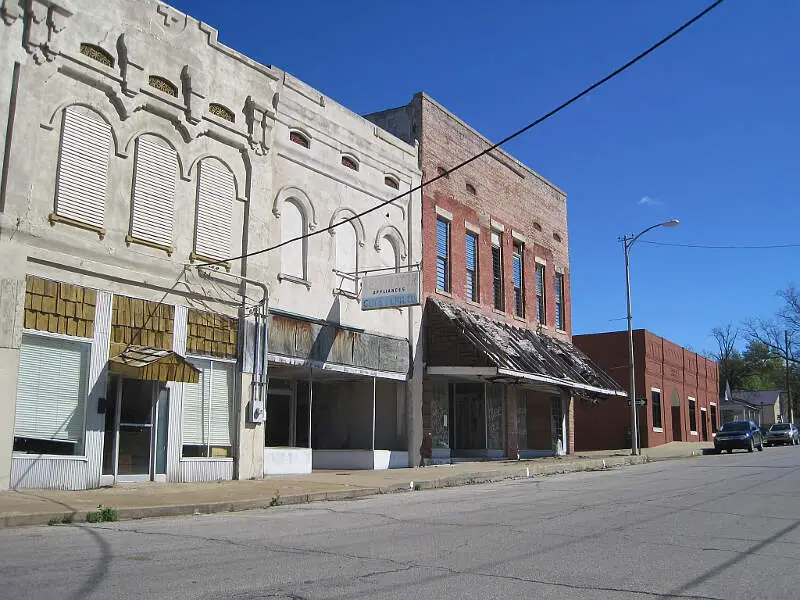
/10
Population: 12,807
Violent Crimes Per 100k: 2,209 (Second most dangerous)
Property Crimes Per 100k: 4,107 (Tenth most dangerous)
Murders: 12
More on Forrest City: Data | Crime | Cost Of Living
Forrest City is named for a Civil War general, Nathan Bedford Forrest.
A fearsome leader in the bloodiest conflict in America’s history — that’s a violent legacy that lends this city its name. Given that pedigree, maybe it shouldn’t come as a surprise that the community winds up on this list. Nope, true to its namesake, Forrest City ranks as the number 5 most violent area in Arkansas.
This plays out in the raw statistics. With only 12,807 people living in town, Forrest City reported 12 murders and 6 sexual in the latest year.
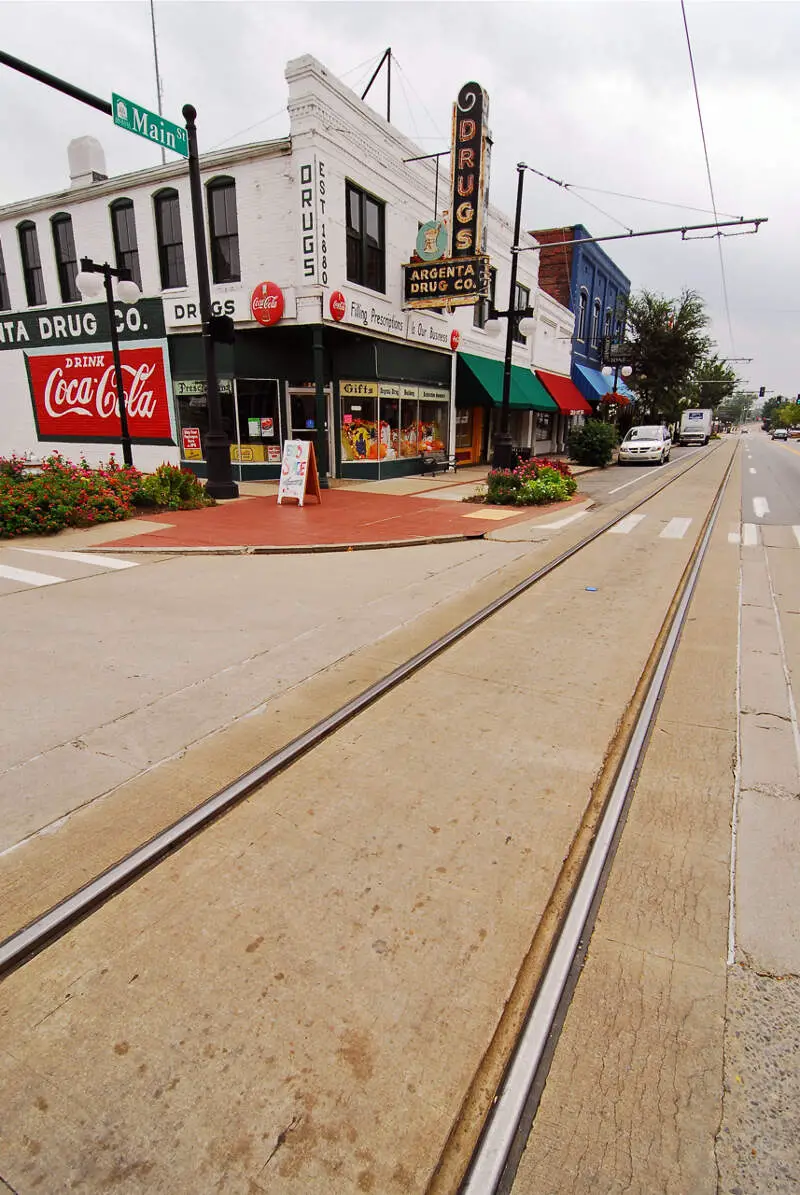
/10
Population: 63,663
Violent Crimes Per 100k: 1,229 (Tenth most dangerous)
Property Crimes Per 100k: 4,633 (Seventh most dangerous)
Murders: 18
More on North Little Rock: Data | Crime | Cost Of Living
Located in Pulaski County, North Little Rock is the sixth most dangerous city in Arkansas for 2024. Known as the twin city of Little Rock, this place has a population of 63,663. However, it grapples with significant crime rates. The city reported 783 violent crimes, including 18 murders, making it the 11th deadliest city in the state.
North Little Rock also contends with high levels of property crime. There were 2,950 reported incidents of property crime. This results in a property crime rate of 4,633/100k, making it the city with the 7 highest rate in the state.
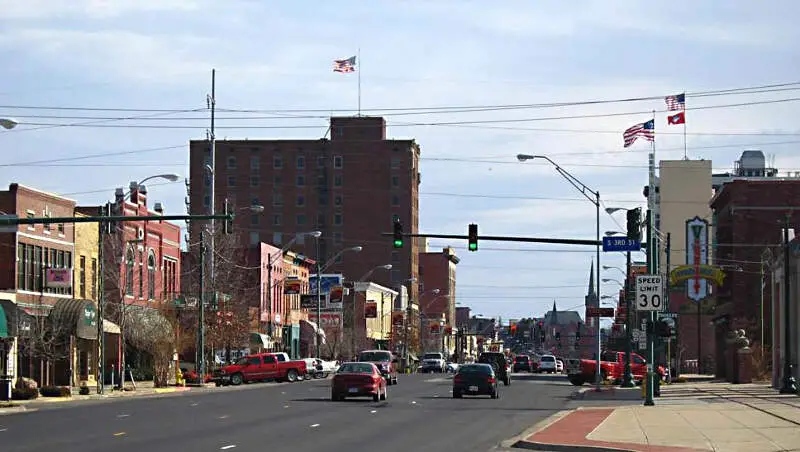
/10
Population: 90,013
Violent Crimes Per 100k: 1,044 (15th most dangerous)
Property Crimes Per 100k: 4,943 (Fifth most dangerous)
Murders: 3
More on Fort Smith: Data | Crime | Cost Of Living
Fort Smith has a lot of things to boast about. It’s one of the biggest cities in Arkansas, it’s one of the best places to retire, it’s a great place for singles, and it’s one of the best college towns in Arkansas. Unfortunately, it’s also one of the most dangerous cities in Arkansas too.
Located on the Arkansas-Oklahoma border, Fort Smith is situated at the junction of the Arkansas and Poteau Rivers. Fort Smith residents have a 1 in 20 chance of being a victim of a property crime, including burglary, car theft, and larceny. And, they have a 1 in 95 chance of being a victim of a violent crime, such as rape, murder or aggravated assault. Keep an eye out for your belongings and be aware of your surroundings in Fort Smith.
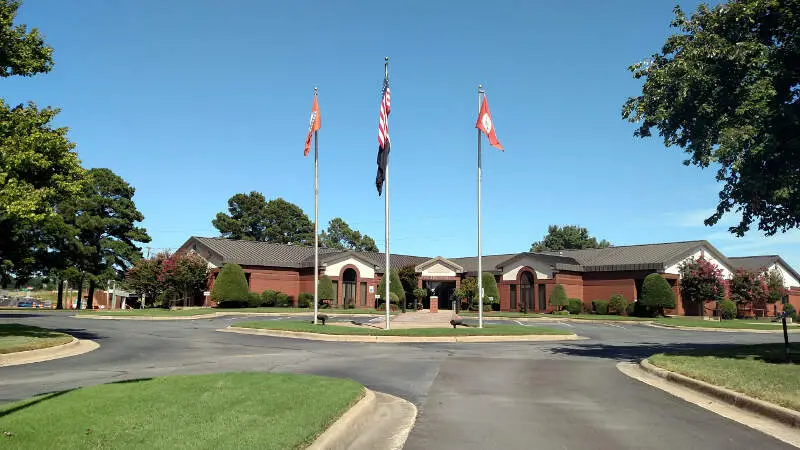
/10
Population: 29,136
Violent Crimes Per 100k: 1,122 (13th most dangerous)
Property Crimes Per 100k: 4,633 (Eighth most dangerous)
Murders: 4
More on Jacksonville: Data | Crime | Cost Of Living
Jacksonville, a suburb of Little Rock, is part of the Little Rock-North Little Rock Conway Metropolitan area. With Little Rock ranked at top of this list, it’s easy to see why some of that crime would spill over to this smaller community.
Jacksonville ranks 13th highest in violent crime and eighth highest in property crime. So residents are more likely to be a victim of burglary, larceny, and car theft in this town. You’ll want to make sure you keep a close eye on your valuables in Jacksonville.
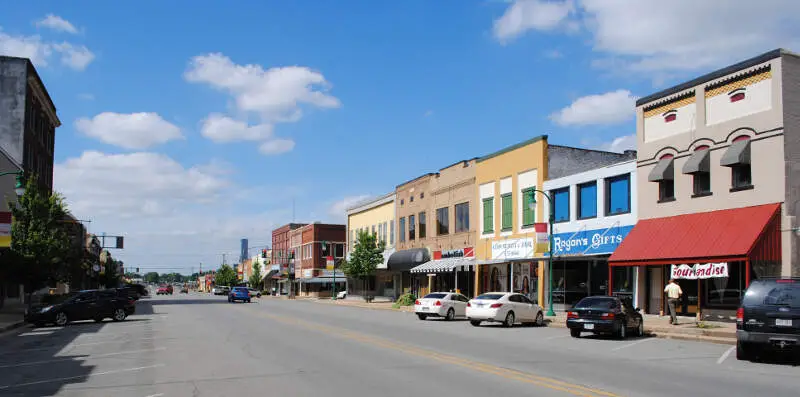
/10
Population: 7,847
Violent Crimes Per 100k: 1,185 (11th most dangerous)
Property Crimes Per 100k: 3,874 (14th most dangerous)
Murders: 3
More on Stuttgart: Data | Crime | Cost Of Living
Stuttgart, the county seat of Arkansas County in the northern part of Arkansas, is known as the “Rice and Duck Capital of the World.” Established by German settlers, this city is strategically located on U.S. Route 165, southeast of Little Rock. However, Stuttgart’s rich history and strategic location are overshadowed by its crime rate.
Stuttgart ranks as the ninth most dangerous place to live in Arkansas, due to 93 instances of violent crime and 304 incidents of property crime among its population of 7,847. This equates to a violent crime rate of 1,185/100k and a property crime rate of 3,874/100k.
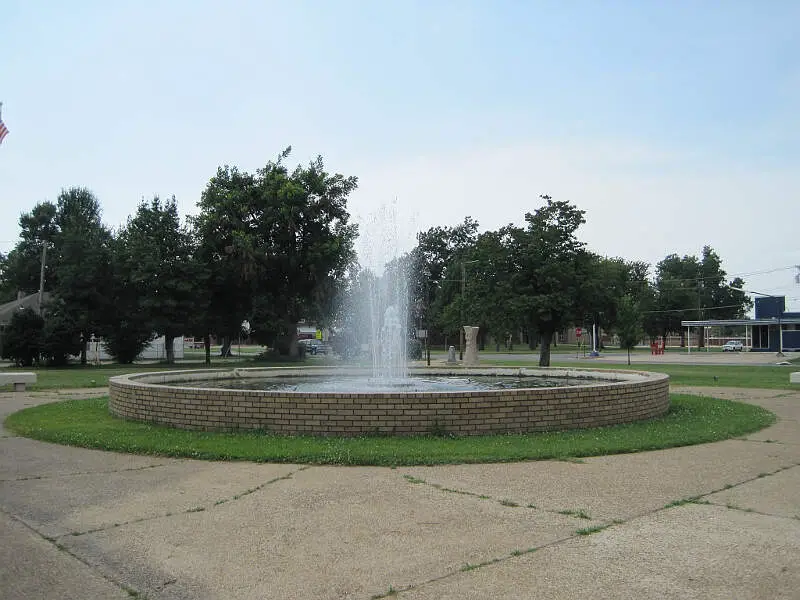
/10
Population: 12,732
Violent Crimes Per 100k: 966 (18th most dangerous)
Property Crimes Per 100k: 4,107 (Ninth most dangerous)
Murders: 3
More on Blytheville: Data | Crime | Cost Of Living
Blytheville, the tenth most dangerous place to live in Arkansas, has earned this reputation due to its concerning crime statistics. With a population of 12,732, Blytheville has experienced 123 violent crimes, including 3 murder cases, 6 rapes, 8 robberies, and 106 aggravated assaults. These crime rates contribute to a general sense of insecurity and danger within the city.
Located in Mississippi County, Blytheville is the county seat and the largest city in the area. It is situated north of West Memphis and has a rich history dating back to its founding in 1879.
Crime By City In Arkansas
| Rank | City | Population | Total Crimes Per 100K | Violent Crimes Per 100K | Property Crimes Per 100K | Murders |
|---|---|---|---|---|---|---|
| 1 | Little Rock | 201,513 | 7,181 | 1,833 | 5,348 | 79 |
| 2 | West Memphis | 23,809 | 7,387 | 2,637 | 4,750 | 12 |
| 3 | Newport | 7,335 | 6,802 | 1,622 | 5,180 | 0 |
| 4 | Pine Bluff | 39,549 | 6,748 | 1,628 | 5,120 | 17 |
| 5 | Forrest City | 12,807 | 6,316 | 2,209 | 4,107 | 12 |
| 6 | North Little Rock | 63,663 | 5,863 | 1,229 | 4,633 | 18 |
| 7 | Fort Smith | 90,013 | 5,988 | 1,044 | 4,943 | 3 |
| 8 | Jacksonville | 29,136 | 5,755 | 1,122 | 4,633 | 4 |
| 9 | Stuttgart | 7,847 | 5,059 | 1,185 | 3,874 | 3 |
| 10 | Blytheville | 12,732 | 5,073 | 966 | 4,107 | 3 |
| 11 | Paragould | 30,296 | 4,944 | 1,142 | 3,802 | 0 |
| 12 | Camden | 10,499 | 4,933 | 1,381 | 3,552 | 1 |
| 13 | Helena-West Helena | 8,874 | 5,059 | 1,656 | 3,403 | 5 |
| 14 | Trumann | 7,283 | 4,929 | 919 | 4,009 | 0 |
| 15 | El Dorado | 17,037 | 4,906 | 1,731 | 3,175 | 9 |
| 16 | Osceola | 6,621 | 5,165 | 2,144 | 3,020 | 3 |
| 17 | Hot Springs | 38,174 | 6,376 | 513 | 5,862 | 5 |
| 18 | Texarkana | 29,339 | 4,638 | 995 | 3,643 | 7 |
| 19 | Hope | 8,535 | 4,569 | 1,031 | 3,538 | 3 |
| 20 | Malvern | 10,824 | 4,443 | 757 | 3,686 | 0 |
| 21 | Wynne | 8,234 | 4,104 | 1,056 | 3,048 | 2 |
| 22 | Fayetteville | 96,456 | 4,536 | 503 | 4,032 | 2 |
| 23 | Searcy | 23,175 | 4,207 | 513 | 3,693 | 2 |
| 24 | Jonesboro | 79,865 | 3,970 | 646 | 3,324 | 9 |
| 25 | Magnolia | 11,059 | 3,987 | 542 | 3,445 | 3 |
| 26 | Morrilton | 7,104 | 4,363 | 380 | 3,983 | 1 |
| 27 | Marion | 13,602 | 3,484 | 705 | 2,779 | 2 |
| 28 | Sherwood | 33,232 | 3,343 | 776 | 2,566 | 1 |
| 29 | Conway | 66,487 | 3,420 | 577 | 2,842 | 7 |
| 30 | Russellville | 29,533 | 3,409 | 558 | 2,851 | 0 |
| 31 | Van Buren | 23,533 | 3,594 | 450 | 3,144 | 1 |
| 32 | Siloam Springs | 17,957 | 2,817 | 568 | 2,249 | 0 |
| 33 | Springdale | 90,892 | 3,068 | 545 | 2,522 | 4 |
| 34 | Mena | 5,652 | 3,644 | 371 | 3,273 | 1 |
| 35 | Heber Springs | 7,353 | 3,087 | 530 | 2,556 | 0 |
| 36 | Ward | 6,621 | 2,643 | 694 | 1,948 | 0 |
| 37 | Alma | 5,874 | 3,064 | 408 | 2,655 | 0 |
| 38 | De Queen | 6,069 | 2,718 | 477 | 2,240 | 3 |
| 39 | Beebe | 8,683 | 2,694 | 495 | 2,199 | 0 |
| 40 | Monticello | 8,200 | 2,512 | 512 | 2,000 | 1 |
| 41 | Benton | 36,282 | 3,155 | 344 | 2,811 | 3 |
| 42 | Mountain Home | 13,180 | 3,194 | 311 | 2,883 | 2 |
| 43 | Berryville | 5,727 | 3,544 | 209 | 3,335 | 0 |
| 44 | Pocahontas | 7,657 | 2,860 | 365 | 2,494 | 0 |
| 45 | Rogers | 72,115 | 2,529 | 395 | 2,134 | 1 |
| 46 | Bryant | 21,407 | 3,596 | 121 | 3,475 | 2 |
| 47 | Batesville | 11,129 | 2,237 | 404 | 1,833 | 0 |
| 48 | Warren | 5,325 | 2,215 | 356 | 1,859 | 0 |
| 49 | Cabot | 26,750 | 2,041 | 370 | 1,671 | 2 |
| 50 | Sheridan | 5,073 | 1,852 | 335 | 1,517 | 0 |
Methodology: How we determined the most dangerous cities in Arkansas for 2024?
Every year the FBI release two crime datasets on cities in Arkansas. First a preliminary dataset limited to the biggest cities in Arkansas, followed by a more detailed release at the end of the year.
For our analysis, we focused on the 2022 data, specifically the 2022 Crime In The United States Report for Arkansas.
So what criteria did we use? Have a look:
- Violent Crimes Per Capita
- Property Crimes Per Capita
In order to make the analysis as apples to apples as possible, we only considered Arkansas cities over 5,000 in population. That left us with 67 cities in Arkansas.
We then ranked each city from 1 to 67 for the two criteria with a #1 ranking being the most dangerous for the particular criteria.
Next, we averaged the two rankings into one “Dangerous Index”.
Finally, we ranked every city on the “Dangerous Index” with the lowest index being the most dangerous in Arkansas — Little Rock. Any ties went to the smaller city.
This article is an opinion based on facts and is meant as infotainment. It is our tenth time ranking the most dangerous places to live in Arkansas and is updated for 2024.
Most Dangerous Places To Live In Arkansas FAQs
Yes, Arkansas is a dangerous state as it ranks as the #3 most dangerous state in the United States based on our analysis of the latest FBI Crime Data. The violent crime rate in Arkansas ranks fourth most dangerous in the United States — 81.7% worse than US average violent crime rate. The property crime rate in the Natural State ranks eighth most dangerous in the United States — 33.72% worse than US average property crime rate. The latest reporting year from the FBI was 2022.
Yes, Little Rock is a dangerous city. Little Rock ranks as the #8 most dangerous out of 328 major cities over 100,000 people in the United States based on our analysis of the latest FBI Crime Data. Keep in mind that are always safe and dangerous parts of any city, so even though Little Rock might be considered dangerous you still need to be aware of where you are. For example, Heights is the safest in Little Rock, while Stephens is considered dangerous by many based on recent crime stats.
Compared to other big cities, the violent crime rate in Little Rock ranks third highest in America — 231.18% worse than US average violent crime rate. The property crime rate in the ranks 16th highest in the United States — 96.01% worse than US average property crime rate. Note the latest reporting year from the FBI was 2022 and that no city in America is ‘dangerous’. Despite the uptick in murders, it’s nothing like you’d see in Tijuana or Caracas where the murder rate is 2x any American city.
Graphing The Most Dangerous And Safest Places In Arkansas
Summary: Locking It All Up In Arkansas
So what is the most dangerous city in Arkansas? After analyzing 67 cities in Arkansas, Little Rock takes the top spot as the most dangerous city in Arkansas based on the most recently reported FBI data — 2022.
The latest FBI crime data shows that Little Rock ranks as the most dangerous city in Arkansas for 2024.
The most dangerous cities in Arkansas are .
We want to point out again that there’s still safes places in Little Rock and that this isn’t a comment on the people that live there. So please don’t beat us up.
What is the most dangerous place in Arkansas? The most dangerous place in Arkansas is Little Rock.
The top ten most dangerous places in Arkansas should come as no surprise to the good people of Arkansas. These cities helped solidify the state as the 3rd most dangerous state in the country.
Learn more about the safest places in Arkansas.
If you’re looking for something more national, check out the most dangerous cities in America or the most dangerous states in America.
Here are the safest cities in Arkansas:
- Pea Ridge (Pop. 7,643)
- White Hall (Pop. 5,579)
- Maumelle (Pop. 19,273)
- Lowell (Pop. 10,402)
- Bella Vista (Pop. 31,316)
- Farmington (Pop. 8,862)
- Centerton (Pop. 21,927)
- Greenwood (Pop. 9,705)
- Cave Springs (Pop. 6,218)
- Greenbrier (Pop. 5,954)
For more Arkansas reading, check out:
- Best Places To Live In Arkansas
- Cheapest Places To Live In Arkansas
- Best Places To Raise A Family In Arkansas
- Safest Places In Arkansas
- Worst Places To Live In Arkansas

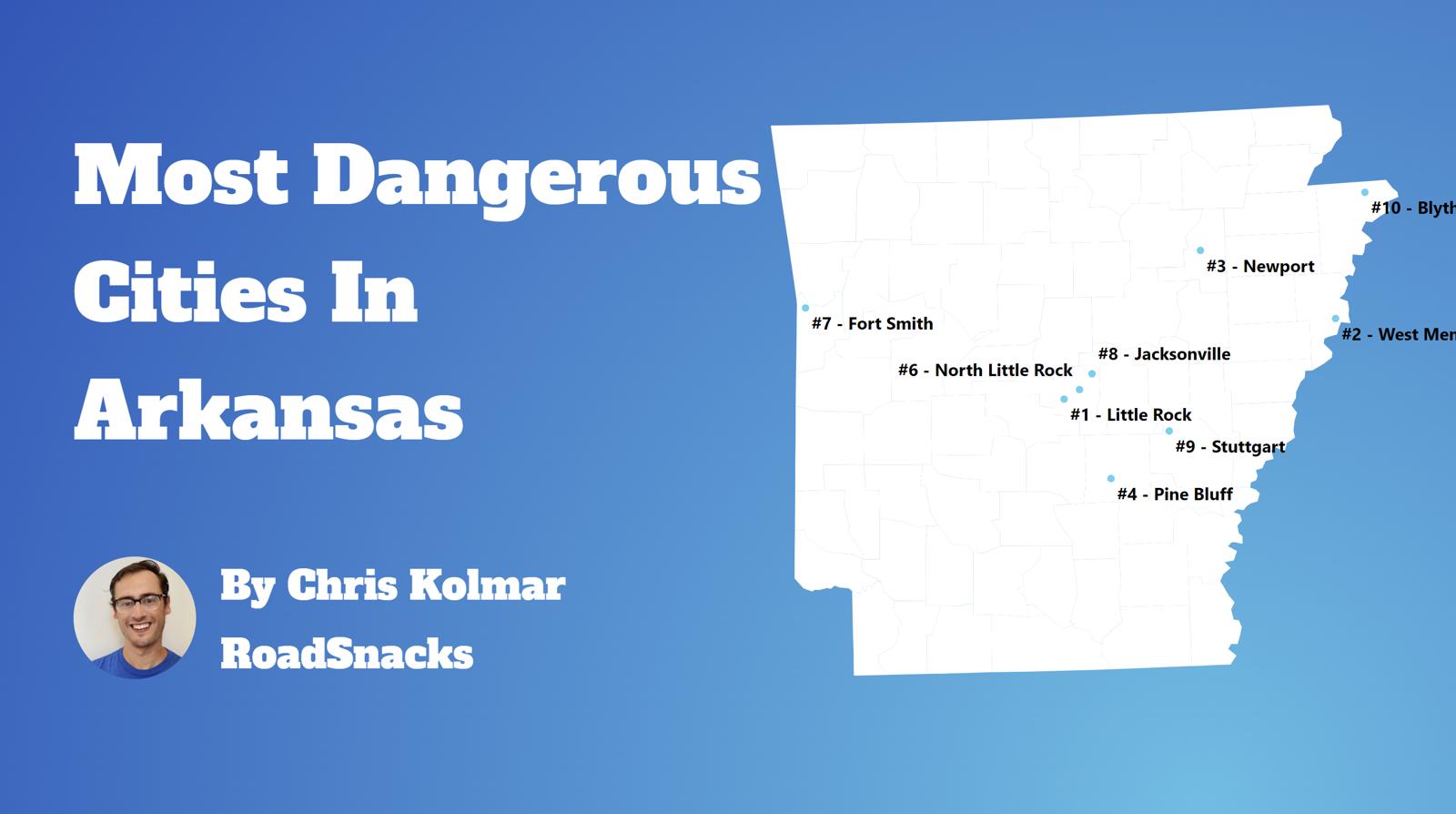
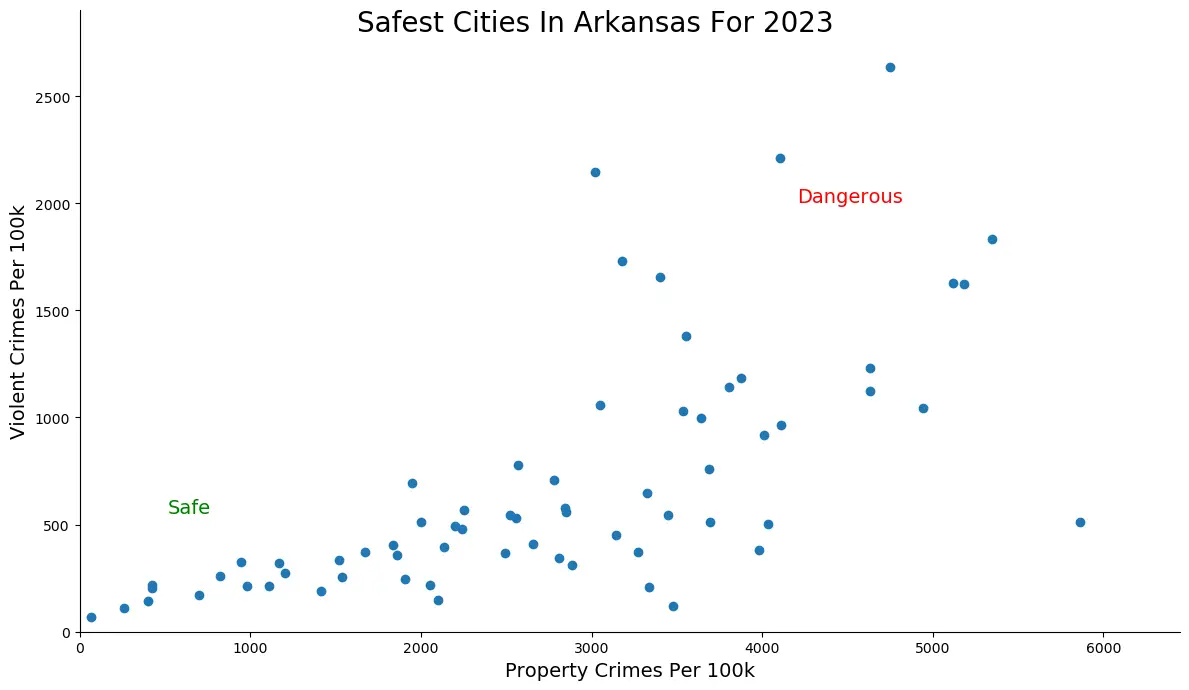
Blytheville Arkansas is located in the North East corner of Arkansas and is only minutes from Missouri
Great place to have grown up in the 70’s. (A whole lot of very troubled young people with way too easy access to alcohol and all manner of recreational drugs where so many dreams turned to despair and the clouds began closing in long ago.)
Who wrote this article? And did they not think to have someone proof read it before posting to the World Wide Web? This is awful and a poor representation of your company/brand/blog/whatever this is supposed to be.
First of all, Little Rock is not a state, it is the state’s Capitol. Second, Blytheville does not have an “S” in it. Third, there are no states within a state, as suggested by the line “Little Rock has, by far, more crime than any other state in Arkansas.” Fourth, Blytheville is in the northeast corner of the state, not northwest. Finally, did you even confirm the landmarks and buildings in the photos used? I’ve been to every town listed and these buildings are not in the cities you sited.
Next time you decide to write an article about a state you CLEARLY know nothing about, my suggestion would be to proof read. Even the best BS’ers proofread. I have lived in Arkansas my entire life and within three seconds of reading this, I knew you were clueless. Maybe that doesn’t matter to you, but if you are presenting information on a particularly specific topic (meaning everything is factual, such as city names and locations and crime rates), you will never be a trusted source if you continue to produce content such as this piece.
By the way, I grew up about ten minutes outside of Pine Bluff, AR, and you COMPLETELY missed this city, it would be number one on the list.
Excellent reply! I checked their source data and Pine Bluff wasn’t even in the top 150 cities listed in AR for “FBI crime statistics”. Laugh out frikkin LOUD! Yet Fort Smith, home of the US Marshal Service is 15th most dangerous? Yet only 49th “most miserable” out of 90. This is a big reason why I hate statistics. You can make them say whatever it is you want them to say but it always leaves out some of the most basic truths…
What complete crap. You’re just selling fear to frightened people. How do you sleep?
Ok, so he isn’t to good at facts an spelling, but this was done back in 2013, fast forward 2 yrs. Where do these towns a cities rate now?
Did I miss something? Where’s Pine Bluff?
Something’s weird about this list.
I have lived in Pine Bluff for 6 years and after moving here from Miami, have seen more crime than anywhere I have ever live and it’s n ot even on the list. It is DANGEROUS here. How could you not include Pine Bluff. It is most likely #1.
Pine Bluff nowhere on list. That hard to believe. When I lived there my house got broken into twice, almost got robbed once, and twice nearly got car jacked. Live there, you better carry a firearm.
Texarkana is very bad. The serial rapist Ricky Williams is from Texarkana. I think he still lives there.
Thida should’ve made the list. Unless you live in Thida you will not come back. Stay away.
I lived in Arkansas in the 60’s it’s hard for me to believe what has been written, at the age of 18 , I got my first job in Osceola, it was a quiet town with happy people living there.My Daddy is even buried in Osceola, we live in Dyess where he was A cotton farmer.
How can Osceola, which was ranked # 2 in 2016, completely drop off the list ln 2018? No way and no how.
They didn’t report data for 2018.
Ive lived in Thida
Why can’t the governor assist the mayors of these cities with solving these crimes. Murder is on the rise in Helena-west Helena, AR. when I lived here, there wasn’t any young people murdering, selling or taking drug, but that was back in the 70’s. The children need something to do, maybe a center where they can learn music and sing, or computer training, such as cyber security training so that they will be able to obtain jobs that will provide higher wages when they graduate from high school, not only younger people, but any one that needs a job that will pay them a decent salary. Technical skills are a must now. If our people are not training with new technical skills for future jobs, most will suffer financial. We must have the necessary skills in order to work those jobs, technology is changing so fast, that we can barley keep up with it all, our cars, medical devices, stores, future houses will be smart houses, Robots, will be a part of technological advancement, smart cars will be able to check our blood pressure and send it to our providers these are just a few of the advancements, there will be many by the year of 2025, that is how fast technology is advancing. I live in Chicago, but is connected to West Helena, Arkansas, because I have family there.
Im from Blytheville Arkansas and it is an okay town. It can be dangerous every blue moon. The thing i find funny about this video is that the pictures of the video wasnt showing Blytheville. Instead you where giving your audience pictures of Jonesboro Arkansas. LOL HAHAHAHAHAHAHAHAHAHA try it again.
I agree about Pine Bluff not being higher up on the list, I also question why Malvern is so far down on the list. My family and I live on the outskirts of Malvern, inmates escape from the county jail and aren’t captured for days or longer if at all. Drug busts and gang related crimes and it is in the last 20 or so on the list. Originally from Hot Springs for 20 years before moving to Hot Spring County and it has become alot more dangerous since we moved away. This statistic list isn’t quite accurate in my opinion.
I’ve lived in Arkansas, specifically Little Rock, my entire life. Your article is spot on regarding unsafe cities in this state. I enjoyed reading it; thank you. I look forward to getting out of Little Rock, if not Arkansas, at some point soon in my life.
I was raised in West Memphis it’s not a bad place people just downgrade it because of the people there because west Memphis have massive houses on the west side so stop it.
This list is not accurate at all and is very slighted. Pine Bluff is not very safe, North Little rock, across from Little Rock is not very safe. In North East Arkansas, Marked Tree, Trumann and Jonesboro, Arkansas are not very safe with high high crime rates. Fayetteville, is not very safe as is Berryville, Russellville and Fort Smith in the North and North West part of the state. The FBI statics will show the true and accurate information. Author of this article should have done a lot more research before publication. With that said, in Arkansas, the true facts are often hidden.